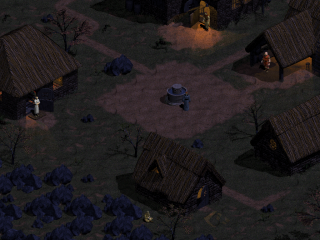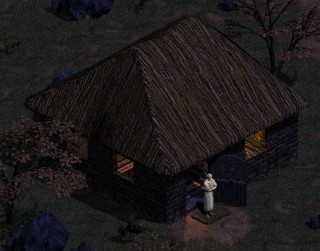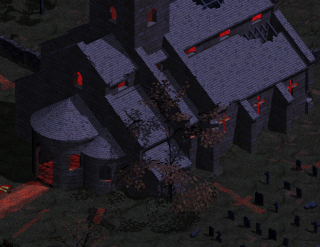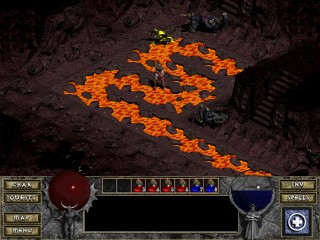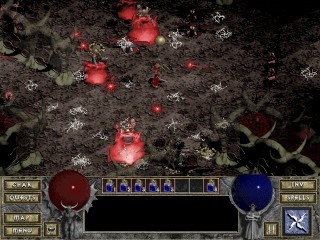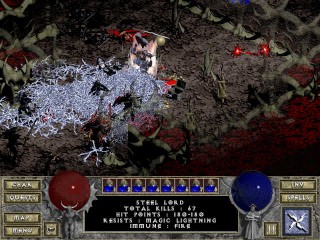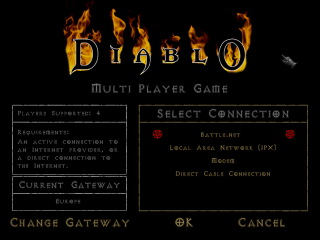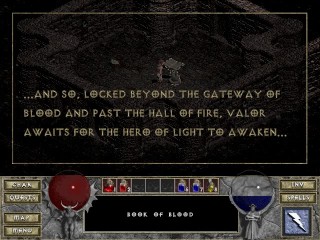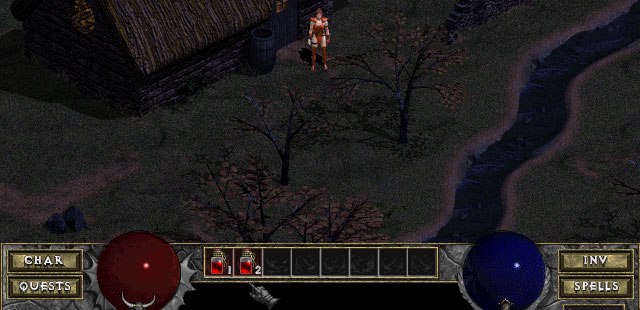
I spent countless hours, playing through Single-Player Diablo games, leveling my rogue to a level 31 and killing Diablo a few times. Why did I do this? I wanted to be able to give a firsthand account of each quest in the single-player of Diablo.
I also wanted to remember why I liked this game so much. Answer? It’s addictive, it’s fun, it’s simple, and every game can be different. It was ahead of it’s time, and apparently, I can still loose myself playing it for hours, long after it’s New Year’s Eve release in 1996.
The game takes place in the town of Tristam, although most of the action takes places under Tristam in four levels of dungeons; the Cathedral, the Catacombs, the Caves and Hell, each with fours levels, giving the game 16 total levels, full of monsters and bosses to hack, shoot or burn.
How do you want to kill the monsters? Select your class and name your hero. There are only three class choices in Diablo; Warrior, Rogue or Sorcerer. Each has their own primary attribute and a skill. The Warrior can repair objects and utilizes strength as it’s primary attribute (hacker), for the Rogue, it’s disarming traps and dexterity (ranged attack) and for the Sorcerer it’s the ability to recharge staffs and magic (spells). Really it’s your preference.
The single-player story-line has one goal; kill Diablo but getting to his level 16 lair, that’s different every time you play. But before I get ahead of myself, you can’t venture into the depths of the earth on your own. There are plenty of characters within the game to assist, guide and help you along your journey, as well as reward you for completing quests.
Deckard Cain, is the town elder and for a small price he can identify those special items found during your dungeon crawl. He also can tell you more about any quest that might arise than most of the other townsfolk. What would any game be without a good weapon-smith or armorer? Griswold, the blacksmith, will sell you basic an premium items, though within one game his stock only changes when you level up. He can also repair your existing items but his most useful ability is of buying the weapons that you find in the dungeons, turning that useless ax for a rogue or the useless bow for a sorcerer into cold, hard gold.
Pepin the healer is the most helpful of all non-player characters in the game. Not only does he sell potions, scrolls and elixirs, but he will heal you at no cost. His inventory seems to change or get replenished every time you go into the dungeon and return to town, but don’t worry, he never runs out of potions of healing or full healing.
Adria the witch, is similar to Pepin in that she never runs out of potions of mana or full mana. Her inventory also changes often, although it appears to be more random to me and not quite as often as Pepin’s. She will by any staff you find that you don’t want to hold on to, but the most important thing that she sells are books. With enough money, it’s easy to buy books from Adria to level up your spells. She also sells elixirs and will recharge your staff for a price.

Wirt the Peg-Legged Boy
The last character that isn’t just a talking head is Wirt, the peg-legged boy. He is a salesman of sorts, give him 50 gold and he’ll show you a wildly expensive premium item. The downfall to this being that you have to give up 50 gold to even see the item, whether you would like to buy it or not. However, when you get up there in levels and start playing games on higher difficulties, money isn’t the issue it is starting out, and you’ll find yourself frequenting Wirt a little more often, his inventory also changes when you level up.
As I mentioned earlier the rest of the characters are just talking heads, Ogden the Barkeep, Gillian the maid, and Farnham the drunk, who is by far the most entertaining of them all to ask about the quests you encounter.
As I said before there are different levels under Tristam. First up is the Cathedral, that you access through the church. This dungeon is mainly consisting of Skeletons, Zombies, Scavengers, and Fallen, they make up the weakest of the monsters, but that doesn’t mean you should sleep walk through these first four levels, the quests, should you choose to accept them are challenging this early on in the game.
The quests within the Cathedral are some of the most well-known because they also exist in the multiplayer levels, those being the Butcher on level 2 and the Skeleton King on level 3. But some singleplayer games can also have The poisoned water supply, Gharbad the Weak, or Ogden’s sign. Of these, it’s the water supply and Ogden’s sign that stand out, if for no other reason than both encompass monsters well beyond the normal found in the Cathedral levels.
The Catacombs contains Goat Men, Hiddens, and Gargoyles. The actual catacombs are much darker and maybe, with the exception of Hell, are the darkest part of the dungeon. The quests therein are the Magic Rock, Valor, Chamber of Bone, Halls of the Blind and Zhar the Mad. Although there is a nice weapon waiting for you after the Magic Rock and some nice accessories after Halls of the Blind, Valor and the Chamber of Bone are the best quests in the Catacombs.
Valor, is about finding Arkaine’s Valor, one of the greatest armors in the game, but the Chamber of Bone is beyond useful, especially if you’re leveling though single-player games. The Chamber of Bone contains one main room full to the brim with skeletons and just beyond is a tome where you can learn or level up you spell of Guardian, a very useful spell. Additionally, pull the two levers and you’ll open two not so hidden rooms, that each contain chests with special items. Overall, the Chamber of Bone quest is probably the greatest in the game and one that when you encounter it in you’ll want to complete.
The Caves consists Balrogs and Demons; Horned, Lightning and Magma and only has two possible quests, the Black Mushroom and the Anvil of Fury. The Black Mushroom is a great quest, although tedious, one has to open the Fungal Tome, speak to Adria, Find the mushroom, speak to Adria and Pepin, then get a monster brain and return to town, where you will be rewarded with the Spectral Elixir, that gives you +3 to all character attributes. It’s very much worth the errand running.
Hell, consists of Mages, Knights, Vipers and Succubi. The quests in Hell with the exception of Lachdanan are part of the game. You need to defeat the Warlord of Blood on level 13 to get down to level 14, you need to kill the Archbishop Lazarus to open the doorway to the final level and Diablo, which is the point of the game and the final quest. Of these, Lachdanan is the only optional one, but it’s also not the easiest. You only have to find an elixir and give it to Lachdanan, but in Hell, as dark as it is, you can easily overlook it and the payoff never seemed worth it, as the elixir is usually the level under where you meet him and you have to backtrack to give it to him.
As for Diablo, there are many ways to handle him, but I find it’s better to use my Guardian spell, to get rid of some of his lesser protectors and then just target him, afterall, when Diablo goes down, the game is over. However, when Diablo goes down the game IS over, so if you have anything laying around in town, you’ll either have to load the game to before you killed him, or take what you can carry with you.
Aside from the character you choose, how you arm yourself is very much up to you. There are five basic types of weapons; axes, clubs, swords, bows and staves (staffs). Armor on the other hand comes in many shapes and incarnations from rags to full plate mail. But these basic weapons and armors on only part of the story, premium items are the bane of your enemies existence, they give you boosts and improvements as well as arming you and Diablo has it’s own linguistics for these items.
The linguistics pertains to prefixes and suffixes that effect what the item is or does. The prefix of “jagged” gives your weapon “+20% to +35% damage” so a Jagged Bow, will do more damage than a regular bow. Additionally, suffixes do the same thing, so the suffix of “dexterity” will give you “+1 to +6 dexterity”. The idea of prefixes and suffixes is that they can be put together and you can have a “Jagged Bow of Dexterity.” The suffix or prefix to rule them all is “zodiac” as it gives you a +16 to +20 boost to all of your character stats.
The spells, and there are a lot of them 26 in single and 28 in multi (resurrect and heal other don’t exist in single). Of these, again it is to each their own, but I find a few more useful than the rest. Chain Lightning, Guardian, Teleport and Heal are the four I use the most, with Stone Curse as a solid fifth, but only for bosses and special enemies where it works.
Chain Lightning can just clear out a room or area in the Cathedral and Catacombs. This is a very effective spell if you’re trying to level up through the harder difficulties of the game. Guardian is the best ranged attack spell there is. cast a few before going around that corner and wait as your three headed monster clan spouts fire killing most if not all of your enemies. Teleport just makes it easier to move around, especially in single player mode where you can’t just walk into the caves or hell from the beginning of the game and Heal allows you to maximize your inventory by utilizing your mana potions for healing as well as your healing potions. Stone Curse, in early levels is a great equalizer. The Butcher and The Skeleton King are both fast and do a lot of damage, but you can freeze them for a bit and get in your licks, sometimes enough to kill them before their thaw.
In the end how does the single player hold up? Very well, in fact getting to level 30 was fun, but beyond that it can be a bit of a bore. Multiplayer on the other hand, is a completely different story, or at least it was. Battle.net was created for Diablo by Blizzard as the first only gaming service created solely for it’s games. It has since utilized this for StarCraft, World of Warcraft and all of the subsequent sequels to Diablo. It allowed you to congregate with other users, trade items and go on dungeon crawls, but it did have its downside. It led to widespread cheating and if you weren’t playing with people you knew, you could be killed by a hacked character very easily. Back in the day, I had a character just for the sake of online gaming with strangers. I never cared about what I had in my inventory or what armor or weapon I had and I did meet some nice players, but there were just as many hacks.
Diablo was ahead of it’s time. Although the levels were fairly limited in size, the library of monsters in the game allowed for you to play it without encountering the same monsters in each game. The prefixes and suffixes in the weaponry allow for you to crawl dungeon after dungeon and always find a new or better item than what you were using. And the story line was rich in history that made you want to stay for the vocalized stories in the various tomes found in the dungeons.
All in all, that’s the overview of the game as I replayed it, but when I played it for the first time it was a game that seemed to have everything. Crawling dungeons with friends was fun and it we used to have friendly duels. If you killed another player you got to keep their ear as a trophy. This game may have gotten lost in time as do many, that have sequels, but the original still holds up. Play it and you’ll realize that. Or if you never played it discover it for the first time, you won’t be disappointed.
Diablo remains one of the greatest games in PC gaming history. It’s the premier hack and slash dungeon running game there is, or at least that there was. It laid the foundations of Blizzard Entertainment and what it has become today. It also laid the foundations for World of Warcraft, a game that I believe could not have existed if not for the overwhelming success of Diablo.
Go on, play it again, you’ll find it just as exciting as it was on New Year’s Eve 1996.

